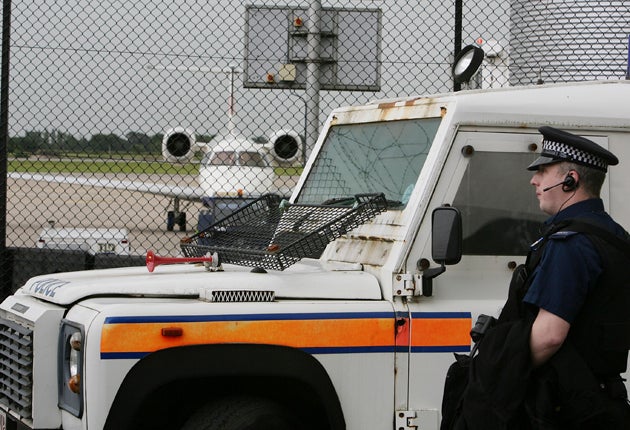Your support helps us to tell the story
From reproductive rights to climate change to Big Tech, The Independent is on the ground when the story is developing. Whether it's investigating the financials of Elon Musk's pro-Trump PAC or producing our latest documentary, 'The A Word', which shines a light on the American women fighting for reproductive rights, we know how important it is to parse out the facts from the messaging.
At such a critical moment in US history, we need reporters on the ground. Your donation allows us to keep sending journalists to speak to both sides of the story.
The Independent is trusted by Americans across the entire political spectrum. And unlike many other quality news outlets, we choose not to lock Americans out of our reporting and analysis with paywalls. We believe quality journalism should be available to everyone, paid for by those who can afford it.
Your support makes all the difference.The UK terrorist threat level has been downgraded from "severe" to "substantial", Home Secretary Alan Johnson said today.
That means the official assessment of the danger of an attack in the near future has shifted from "highly likely" to a "strong possibility".
Mr Johnson said the country still faces a "real and serious" threat from terrorists and urged members of the public to remain vigilant.
The Joint Terrorism Analysis Centre, a unit within MI5, sets the level based on an analysis of intelligence.
The assessment covers potential attacks by al Qaida or linked extremist groups and the threat from dissident Republican and Loyalist terrorists in Northern Ireland.
There are five levels of threat, ranging from low - meaning an attack is unlikely, to critical - when an attack is expected imminently.
Mr Johnson said: "The Joint Terrorism Analysis Centre has reduced the threat to the UK from international terrorism from Severe to Substantial.
"This means that an attack on the UK is a strong possibility. JTAC make their judgments based on a broad range of factors, including the intent and capabilities of international terrorist groups in the UK.
"We still face a real and serious threat from terrorists and the public will notice little difference in the security measures that are in place, and I urge the public to remain vigilant.
"The police and security services are continuing in their thorough efforts to discover, track and disrupt terrorist activity."
The threat level was made public for the first time on August 1, 2006, when it was set at severe.
It was raised to critical on August 10 that year after a series of arrests over an alleged plot to blow up transatlantic aircraft, but lowered to severe again the following week.
The threat level was last at critical in June 2007, following the attack on Glasgow Airport and the failed car bombings in central London.
Earlier this month, the country's most senior counter-terrorism officer, John Yates, hinted at the possibility of a change.
He told the Association of Chief Police Officers' conference in Manchester: "I think there is a possibility the threat level may come down.
"It is logical because we cannot keep having it high unless the threat is there."
The level is under constant review and can change quickly in response to events.
The shift means the threat level is now at its lowest since May 2005 when it was set at substantial - two months before the July 7 bombings.
At the time the threat was rated under a slightly different system and not made public.
Here are the different categories of threat from terrorism as published by the Joint Terrorism Analysis Centre. Today the level was moved from "severe" to "substantial".
How the terror threat is categorised
Low - an attack is unlikely
Moderate - an attack is possible, but not likely
Substantial - an attack is a strong possibility
Severe - an attack is highly likely
Critical - an attack is expected imminently

Join our commenting forum
Join thought-provoking conversations, follow other Independent readers and see their replies
Comments